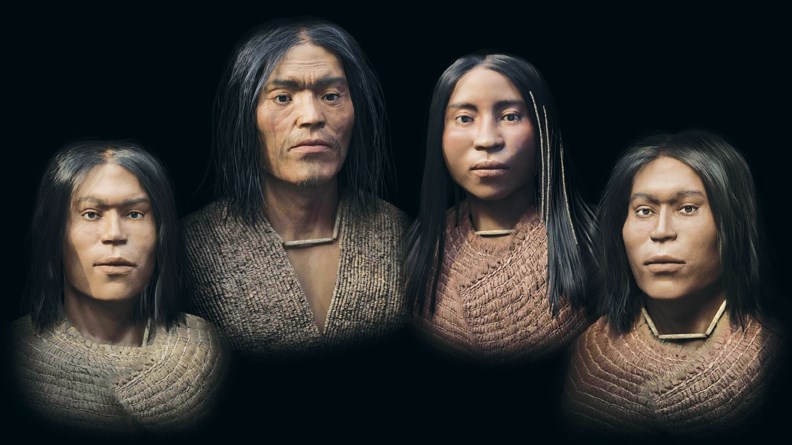Chief Warren Paull says shíshálh Nation members are as excited about a new museum exhibit featuring one of their ancient chiefs and his family as they were when the first pictures were released in May.
The exhibit, “kw’en-usitsht tems stutula (we are face-to-face with our ancestors),” will open to the public at the Tems Swiya Museum in Sechelt on July 4.
The exhibit centres on an incredible discovery by the shíshálh Archeological Research Project more than 10 years ago. The project team found the remains of five people, believed to have been buried some 4,000 years ago: a man of about 50; a woman between 19 and 23; male twins aged 20 to 25; and one infant. They had been buried with hundreds of thousands of stone and shell beads, indicating they were a family of great wealth and power.
It’s now acknowledged as one of the most significant finds of its kind in North America.
Paull was part of a shíshálh delegation that travelled to Ottawa for a preview of the exhibit, which was created for the new Canadian History Hall at the Canadian Museum of History in Gatineau, Que., just outside Ottawa.
Matt Betts is curator of eastern archeology at the Museum of History and was responsible for the section of the Hall that will include the story of those early shíshálh people and other indigenous North Americans.
“It was four years of very intensive labour, but the collaborations we were able to do with the shíshálh Nation have been so rewarding,” Betts told Coast Reporter this week. “We can’t wait for the public to see it.”
Curator Raquel Joe and the staff of the Tems Swiya Museum, along with some extra hands brought in to help get everything ready, have been working all month to install a duplicate of the display at the Museum of History, and Paull said despite being up against a deadline, the mood has been upbeat.
“Everyone’s been having fun with it,” he said.
Paull said the work has involved more than just creating space for the new display. The museum has undergone a complete upgrade that will also allow for exhibits of material that hasn’t been shown publicly before. “It’s actually the first time we’ve given that place a facelift in probably a decade. We’ve brought in all new cases, all the things that had to be done: new lighting, a showcase for the new exhibit.”
Paull joked that installing the Museum of History exhibit has been a bit like building with Lego, or assembling Ikea furniture, and Betts said that’s a pretty accurate description.
“Our design and construction team are among the best in North America,” Betts said. “We had a design that we developed in collaboration with the shíshálh Nation for the exhibit here [at the Museum of History]. We started with that … and Chief Paull is essentially right, it was like an Ikea kit. We built as much as we could here, and shipped it [to Sechelt] almost completely constructed. We even produced an instruction booklet that showed what parts needed to be bolted together.”
Betts said the unprecedented working partnership with the shíshálh Nation went beyond ensuring culture and tradition were respected and the handling of human remains and artifacts was done appropriately. Representatives from shíshálh had a say in every aspect of the display people will see at Tems Swiya.
“[They are] forensically accurate reconstructions, but to bring them to life we needed the involvement of the [shíshálh] community,” Betts said. “They chose the facial hair. They chose the hairstyles. They chose the facial expressions. With their guidance we were able to bring these people to life in a way that was respectful but also engaging.”
The grand opening of the Museum of History’s Canadian History Hall will take place on Canada Day. Paull said the shíshálh Nation decided to hold a special opening for members on June 30, followed by a preview for invited guests and dignitaries on July 1, and then re-open Tems Swiya to the general public on July 4.
Betts said the response from people who’ve already seen the exhibit during tours at the Museum of History has been “better than we ever could have expected.”
“I’ve seen people entranced by the images. I’ve seen people sit and stare at the images up to five minutes making personal connections with these ancient people,” he said. “Every time I’ve toured people through the [Canadian History] Hall, meeting these people face-to-face has been a highlight of the tour… Seeing individuals face-to-face really draws you into understanding their story. These were real people with powerful and complex political systems that had great wealth and complex social structures.”
Paull said he expects the Tems Swiya Museum’s version will also have a big impact on visitors.
He also said the project has started a bigger conversation about a possible future expansion of the museum, and there’s at least one more important project on the near horizon – making room in the museum for the skeleton of J-34, the orca that was found dead near the Trail Islands last December and recovered by shíshálh members.
“That’ll probably be this fall,” Paull said. “We do have the space [now], and there’s enough room in that spot to be able to hang it and do it justice.”
The shíshálh Archeological Research Project, meanwhile, continues its quest to unearth more evidence of the ancient history of the shíshálh people. Archeologist Terence Clark and a team of university students, shíshálh youth and others have launched another season of field work at an undisclosed location in Sechelt Inlet.



